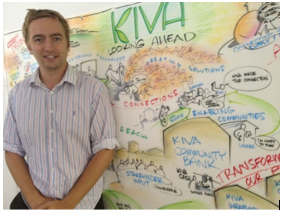California is in the midst of a micro-lending boom, driven by the rise of internet-based crowdfunding sites, including Kiva, Kickstarter, Indiegogo, and RocketHub.
The micro lending sites are opening new lending markets, in peer to peer lending. They are building new ties between lenders and California micro-businesses, with the lender more of a business development partner than a passive lender.
Micro-lending for years has long been an economic development strategy of community training and economic development agencies in California. In the old days of micro-lending—that is pre-early 2000s—micro-lending consisted often of private foundations or wealthy private individuals providing funds for nonprofit intermediaries to disperse.
In 1984, the community training agency I headed, San Francisco Renaissance, started a Renaissance Entrepreneurship Center, which included an entrepreneurship training class and a small loan fund for micro-enterprises. The Center in the late 1980s and 1990s expanded greatly in businesses served, training and locations, thanks to Ms. Claudia Viek, one of the leaders of the micro-lending movement in California for decades, and the current director of the California Association for Microenterprise Opportunity (CAMEO). But even the Renaissance Entrepreneurship Center, which  continues to the present, has depended on a relatively small group of lenders and foundations.
continues to the present, has depended on a relatively small group of lenders and foundations.
Now the micro-lending sites expand the pool of lenders to include individuals of all income levels, and expand the role of the lender. Kiva, based in San Francisco, has been a leader in such lending to business enterprises, and illustrates the micro-lending boom in our state.
Kiva started in 2005, with a focus on loans to entrepreneurs in developing countries. In the past seven years, Kiva has facilitated an astonishing 842,068 loans, totaling over $368 million in 66 countries. The lender can lend as little as $25, and chooses the borrower, based on information provided by Kiva field partners and volunteers around the world. Though the loan is administered by an intermediary financial institution, the lender follows the loan repayment and progress of the business—all made possible by internet technology. 
In recent years, Kiva has become more active with loan making in the United States. Since 2009, when Kiva launched its United States operations, Kiva has made 140 loans in California. (700 in the United States). To expand its United States presence and especially its California presence, Kiva late last year started KivaZip, which eliminates the intermediary institution and can operate with even greater speed and nimbleness.
KivaZip is headed by Mr. Jonny Price (pictured above). Mr. Price is involved in a number of loans himself as a lender, as are many Kiva employees. He is a graduate of Cambridge University, and came to Kiva in 2009 as a volunteer after 6 years at Oliver Wyman, a management consulting firm.
Recently, I joined representatives of the City of Antioch and Contra Costa Small Business Development Center in a meeting with Mr. Price at the Kiva headquarters on Howard Street. The Antioch City government is aggressively pursuing lending strategies to assist Antioch-based businesses. The City Manager, Mr. Jim Jakel, economic development manager, Mr. Brian Nunnally, and Mr. Oscar Dominguez of the SBDC came to KivaZip to discuss a possible Antioch-based program.
By the end of the 90 minute meeting, Mr. Price and the Antioch representatives had a tentative agreement to start a KivaZip program in Antioch within two months. No extensive paperwork, no attorneys drafting/redrafting documents, completely a let’s- move-forward approach: What a contrast with most government programs. (A recent Milken Institute paper by Mr. Bradley Belt, Mr. Chris Brummer, and Mr. Daniel Gorfine, “Crowdfunding: Maximizing the Promise and Minimizing the Peril” examines securities issues regarding crowdfunding sites like Kiva, that eschew most paperwork, and suggests how they can continue to function and expand lending, without onerous regulations.)
Whether a KivaZip lending for Antioch micro businesses will take off in the next few years remains to be determined. It starts off, though, with the access to the Kiva list of users, which now total 1.2 million, including 60,000 in California.
Much is written about how technology is eliminating jobs in California. The micro-lending internet site is one example of how technology is creating jobs in our state.

